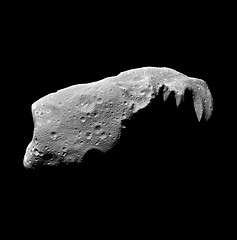
Between Mars and Jupiter floats a little rock with big dreams.
For three whole weeks in January and February, it was designated as 2015 BS515, a near Earth object, one of the many space rocks that astrophysicists keep an eye on for their potential to strike our planet. But then on February 12 came the announcement: the Minor Planet Center (MPC) at the Harvard-Smithsonian Center for Astrophysics had downgraded the rock to a “routine main-belt object.” That means the asteroid is far enough away that we don’t have to worry about it hitting Earth any time soon.
The MPC gets sent two million observations of asteroids and comets every month. The five staff members then catalog these findings and figure out what’s new and what’s been seen before. The goal is to keep track of all near Earth objects, which make up about 1% of the observations the Center receives. It’s remarkable that there are so few corrections, given the 120 million observations on the MPC’s books.
Here’s a portion of the note that appeared in the most recent Minor Planet Electronic Circular (MPEC), which provides updates about comets, “observable unusual objects,” and other asteroid news:
The object designated 2015 BS515 on MPEC 2015-C40 is being retracted. The alleged followup observations, along with an additional night reported under the designation 2015 BS515, belong to a routine main-belt object. The designation 2015 BS515 is therefore being removed. Since the designation did not appear in a permanent MPC publication, the designation will officially be listed as “omitted”.
We emailed with the Minor Planet Center’s interim director Matthew Holman about the decision. The chat is edited lightly for readability.
What happened here?
Someone reported observations of something that was thought to be a newly discovered asteroid. This was given the designation 2015 BS515…This object was thought to be a near Earth object (NEOs, i.e. asteroids that could potentially strike the Earth), hence the announcement. However, it is a “routine main belt asteroid”.
What’s a routine main-belt object/asteroid?
A routine main belt object refers to the large number of objects in what we call the main asteroid belt or main belt. This one is between Mars and Jupiter.
In general, how many reports of this kind of stuff come from hobbyists and how many come from other academic institutions?
The Minor Planet Center now has in excess of 120 million observations in its data base. It is currently receiving more than 2 million new observations each month. The vast majority of those are submitted automatically by a few large surveys, such as the Catalina Sky Survey and the Pan-STARRS-1 survey, which are searching for near Earth objects. A much smaller number of observations are discovered by amateurs. However, amateurs make a very important contribution in tracking NEOs.
Given the large numbers involved, it is actually impressive how few objects need to have their designations changed.
How common are these kinds of designation reversals?
This kind of thing is fairly rare because the Minor Planet Center thoroughly checks to see if reported observations correspond to a known object before assigning a new designation. However, sometimes the orbits of the objects are not yet known well enough to make a clear identification.
Hat tip: Rolf Degen
Ida is a main belt asteroid, not a near earth asteroid. The image was acquired by the Galileo spacecraft on its way to Jupiter.
You might want to correct or retract that caption!
Fixed, thanks!